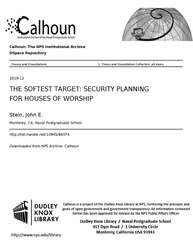File:THE SOFTEST TARGET- SECURITY PLANNING FOR HOUSES OF WORSHIP (IA thesoftesttarget1094564074).pdf

Original file (1,275 × 1,650 pixels, file size: 10.22 MB, MIME type: application/pdf, 150 pages)
Captions
Captions
Summary[edit]
| THE SOFTEST TARGET: SECURITY PLANNING FOR HOUSES OF WORSHIP
( |
||
|---|---|---|
| Author |
Stein, John E. |
|
| Title |
THE SOFTEST TARGET: SECURITY PLANNING FOR HOUSES OF WORSHIP |
|
| Publisher |
Monterey, CA; Naval Postgraduate School |
|
| Description |
Defending houses of worship has become an ever-increasing need in homeland security. The rise of threats against faith-based organizations is growing, and the unique nature of sanctuaries makes them an ever-increasing soft target. What security help can assist houses of worship, and how can homeland security experts advise faith-based organizations? This thesis employs an appreciative inquiry approach to define the security problem that houses of worship face in specific threats and hurdles unique to them. Chapters review available resources at the government level, in the commercial space, and by faith-based organizations themselves. The material was then synthesized by developing an emergency operations plan for one house of worship: Northminster Presbyterian Church in Tucson, Arizona. This thesis suggests that overcoming the hurdles to security strategies within a house of worship is much more nuanced than previously believed, and the construction of a security plan for any house of worship is far more difficult than previously understood. Rather than seeking a one-size-fits-all or a packaged solution, houses of worship would best be served by engaging in a local effort to analyze security challenges and solutions. Little empirical study treats how houses of worship use, acquire, and find value in protection strategies on their campuses, and this thesis starts the conversation into this rarely discussed space. Subjects: church security; mass shootings; soft target; nonprofit security |
|
| Language | English | |
| Publication date | December 2019 | |
| Current location |
IA Collections: navalpostgraduateschoollibrary; fedlink |
|
| Accession number |
thesoftesttarget1094564074 |
|
| Source | ||
| Permission (Reusing this file) |
Copyright is reserved by the copyright owner. | |
Licensing[edit]
| Public domainPublic domainfalsefalse |
This work is in the public domain in the United States because it is a work prepared by an officer or employee of the United States Government as part of that person’s official duties under the terms of Title 17, Chapter 1, Section 105 of the US Code.
Note: This only applies to original works of the Federal Government and not to the work of any individual U.S. state, territory, commonwealth, county, municipality, or any other subdivision. This template also does not apply to postage stamp designs published by the United States Postal Service since 1978. (See § 313.6(C)(1) of Compendium of U.S. Copyright Office Practices). It also does not apply to certain US coins; see The US Mint Terms of Use.
|
 | |
| This file has been identified as being free of known restrictions under copyright law, including all related and neighboring rights. | ||
https://creativecommons.org/publicdomain/mark/1.0/PDMCreative Commons Public Domain Mark 1.0falsefalse
File history
Click on a date/time to view the file as it appeared at that time.
| Date/Time | Thumbnail | Dimensions | User | Comment | |
|---|---|---|---|---|---|
| current | 10:46, 25 July 2020 |  | 1,275 × 1,650, 150 pages (10.22 MB) | Fæ (talk | contribs) | FEDLINK - United States Federal Collection thesoftesttarget1094564074 (User talk:Fæ/IA books#Fork8) (batch 1993-2020 #30373) |
You cannot overwrite this file.
File usage on Commons
The following page uses this file:
Metadata
This file contains additional information such as Exif metadata which may have been added by the digital camera, scanner, or software program used to create or digitize it. If the file has been modified from its original state, some details such as the timestamp may not fully reflect those of the original file. The timestamp is only as accurate as the clock in the camera, and it may be completely wrong.
| Short title | THE SOFTEST TARGET: SECURITY PLANNING FOR HOUSES OF WORSHIP |
|---|---|
| Author | Stein, John E. |
| Software used | Stein, John E. |
| Conversion program | Adobe PDF Library 11.0 |
| Encrypted | no |
| Page size | 612 x 792 pts (letter) |
| Version of PDF format | 1.4 |

